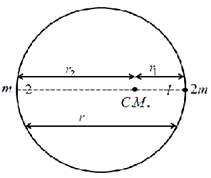11th And 12th > Physics
GRAVITATION THE LAW OF FALLING MCQs
:
A
Here, G = universal gravitation constant
Time period of a satellite above the earth's surface is :
T2=4π2R3GM=3πG⎛⎜⎝M43πR3⎞⎟⎠=3πGρ
or ρT2=3πG = a universal constant.
:
A
Let x be the distance moved by the particle in time t.
Then by conservation of energy −GMmd+0=−GMmd−x+12mv2
Where M is mass of the sun and d is the initial separation.
v=√2GMd√xd−x
dxdt=√2GMd√xd−x
dt=√2GMd∫d0√xd−xdx
t=√d2GM[√x(d−x)−dsin−1√d−xd]d0=√d2GM(dsin−11)
=√d2GM×d×π2
But, GMmed2=meω2d
where me = mass of the earth and ω = angular speed of earth.
∴GM=ω2d2
t=√d2ω2d2×d×π2=π2√2ω=π2√22πTe=Te4√2
:
C
At all places potential will increase by GMR
:
C
v=v0=ve√2 (orbital speed v0 of a satellit near the earth's surface is equal to 1√2 times the escape velocity of a particle on earth's surface)
Now from conservetion of mechanical energy:
Decrease in kinetic energy = increase in potential energy
or 12mv2e2=mgh(1+hR)
or 12m(2gR2)=mgh(1+hR)
or h = R
:
B
Kinetic and potential energies varies with position of earth w.r.t. sun. Angular momentum remains constant every where.
:
C
Time period of a satellite very close to earth's surface is 84.6 min. Time period increases as the distance of the satellite from the surface of earth increase. So, time period of spy satellite orbiting a few hundred km above the earth's surface should be slightly greater than 84.6 min. Therefore, the more appropriate option is (c) or 2 h
:
B
v=√GMr if r1>r2 then v1<v2
Orbit speed of satellite does not depends upon the mass of satellite
:
D
v0=√GMr
:
D
v0=√GMr=√gR2R+h

















